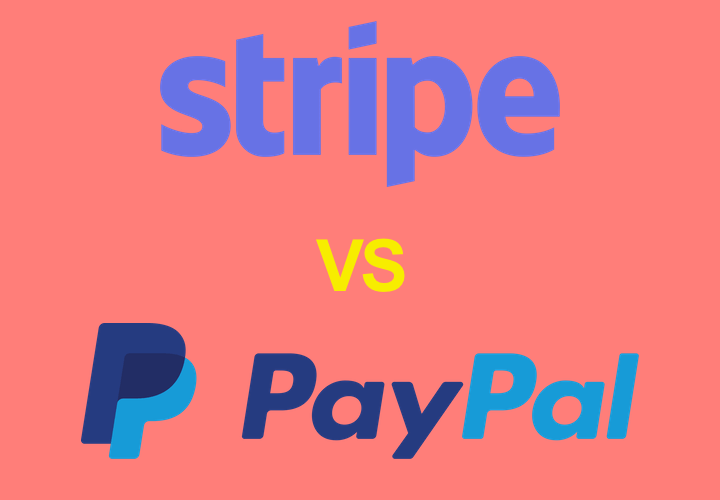When I started my first business 15 years ago I remember having to jump through weeks of processes to gain approval so I could start selling to and charging our first customers. This long process delayed our product launch by several weeks.
Fast forward to now and you can now set up a merchant account in less than 30 minutes and start charging customers right away.
One of the first things you need to do when starting to sell your products online is work out how you are going to collect payments. In this post we’ll be helping you compare Stripe vs PayPal and answer all the most important things you need to know before committing to use one (or both) payment gateways.
Two of the largest and best payment gateway providers are Stripe and PayPal. But which is the better payment gateway? And do you even need to choose just one?
What is PayPal?
PayPal is the grandfather of payment gateways having launched more than 20 years ago. PayPal is also a household name, particularly to those who are looking for a secure and fast way to pay for things online.
PayPal’s payment services are widely recognised as secure and easy to get started with. However, PayPal has a reputation for closing accounts and treating their merchants poorly so we generally recommend that you use PayPal alongside a different payment gateway (discussed below).
What is Stripe?
Stripe is an established player in the payment space. Within 8 years Stripe has risen from a small startup to become a $22.5 billion dollar company with millions of customers and has managed payments for some of the world’s largest brands such as Target, Allianz, Uber and more.
Who is Stripe and PayPal for?
- Need to securely collect payment through your website?
- Need to securely collect recurring or once off payments?
- Need basic protection against fraud?
Stripe and PayPal can both help you with the above issues and more.
Can’t I just use both?
Yes! You can definitely use both PayPal and Stripe and many people will choose to use both. For example, it can be good to have a backup solution in case the other payment gateway has problems. Many people prefer to use only one payment gateway because:
- One payment gateway is missing features they need
- They want to simplify their payment options
- They want to simplify their back office and accounts management
If you are not sure if Stripe or PayPal is the right fit for you, read on and we’ll break things down.
Just how different is Stripe vs PayPal?
1. Transaction fees
PayPal’s base transaction fees at the time of publishing is 2.9% of your transaction + 30 cents.
Stripe’s base transaction fees at the time of publishing is 2.9% of your transaction + 30 cents.
The winner: both are the same, though the fees may change depending on your location and card type.
2. Product and payment types
PayPal can charge using a person’s PayPal account balance and using all major credit cards for once off purchases and recurring purchases. Payment can be made directly on your website but most people use PayPal’s offsite payment page, which forces users to leave your website to pay for their product and then return back to your website.
Stripe is known for its website friendly integrations and can allow your customers to pay using all major credit cards for once off purchases and recurring purchases. Stripe payments are typically done on your website using their simple website integrations.
The winner: PayPal is technically the winner because it has the extra feature to allow people to pay directly from their PayPal account balance on top of all major credit cards.
However the most common product of PayPal requires your customers to leave your website and visit PayPal’s website to finish paying for their product. This can be a poor experience for users, which is why many prefer to use Stripe or acquire PayPal’s premium on-site payment product.
3. Ease of use and setting up
PayPal is simple and easy to set up, once your account is approved with PayPal you can add their simple integration with WooCommerce or another eCommerce platform, add your email or API key and get started right away.
Stripe is also easy and simple to set up, applying for an account is quick, you will need your passport or government ID card to verify your account and then you can use one of Stripe’s integration add-ons with any major eCommerce platform such as WooCommerce by installing the integration add-on and adding your Stripe API keys to the settings page.
The winner: this is a draw, both are easy and fast to set up and both have a great sign up user experience.
4. Payouts and reputation
PayPal uses a payout system, which means that when PayPal charges a customer they hold that money for you until a payout is ordered. With PayPal you can order a “sweep” payout every day automatically so you don’t hold any money in your PayPal account for too long. Or you can order this payout manually any time you want.
PayPal also has a mixed reputation for payout problems and accounts being suspended. I even heard of many cases of people who have been locked out of their PayPal accounts and unable to access their money because of unfair reasons. PayPal support have had a reputation in the past of being less than supportive of these cases but I understand this support has improved dramatically over the years.
Stripe has a great system for ordering money to be transferred into your own bank account whenever you need it, you can view your payments and set up a recurring payout schedule from inside their admin dashboard. The admin dashboard is very detailed and well designed and makes it very easy to get a good view of your transactions, this dashboard is a lot better than PayPal’s equivalent dashboard.
Stripe also has a good reputation for supporting their users and having good support and good controls in place to make sure people don’t get locked out of their accounts for unfair reasons.
The winner: Stripe is the clear winner here as their dashboard is better and their reputation for supporting users is better in our experience. PayPal is a close second.
5. Currencies and international payments
PayPal supports payments from 200 countries and 25 currencies, which means PayPal is very well supported. Yet I was surprised that they did not support more than 25 currencies. Most businesses from outside of those 25 currencies would need to charge in a foreign currency e.g. US dollars.
I have heard many reports of PayPal having terrible exchange rates for foreign currency, so this is also something to consider and research yourself.
Stripe supports payments in 135+ currencies, which is more than most users will ever need. For global businesses this is great solution since people can pay in their currency and it will get converted to your main Stripe account currency. For example, you charge in US Dollars but your website accepts 135+ currencies. That means your users can pay with their credit card from Europe and they get charged the equivalent USD in Euros after they submit payment. Either way you get the exact money you need and we understand Stripe’s foreign exchange rates are reasonable.
The winner: Stripe is the winner, mostly for those people who are not in one of the 25 currencies that PayPal supports. Also PayPal is reported to have worse exchange rates for foreign currencies but this would need additional verification.
6. User experience
PayPal requires users to visit PayPal’s website to make their payment if you use their most common payment gateway solution. Some people see this as a good user experience because many consumers feel safe using a payment gateway that they recognise.
Your brand might be seen to borrow some of PayPal’s reputation for quality in this way by showing yourself as a PayPal partner. However there is still a requirement to leave your website and we think overall this is a worse experience compared with sticking with your branded payment pages.
This is why we generally recommend PayPal’s alternative “pro” products, which are embedded on your website checkout page and allow users to pay but still stay on your website because this is a better user experience.
Stripe is always embedded on your website and used directly on your website. Their popup and inline forms are well designed and never require more information from the customer than is strictly necessary.
The winner: in our experience Stripe is the clear winner with their well designed user experience.
7. Security
PayPal is a secure service with enterprise level protection and 2 factor authentication available to guard your account from hackers. PayPal will also detect your location and other things upon logging in and occasionally give you a hard time when you sign in from a new location, this can be a frustrating experience but is overall a good thing for keeping your account secure.
Stripe is also secure with PCI level 1 security and has 2 factor authentication available to all users (which gives you access to Stripe only after you provide the correct password and a short term expiring code from your phone). These layers of security make Stripe one of the most secure payment gateways around.
The winner: There is no clear winner here, both PayPal and Stripe have strong security reputations and both provide a similar level of security with their accounts.
8. eCommerce, accounting and other integrations
PayPal is one of the most popular payment gateways in the world, which means that it has integrations with almost any application that you would need to integrate with. This includes eCommerce platforms such as WooCommerce and Easy Digital Downloads. PayPal will also integrate with common accounting systems such as Xero and Quickbooks.
Stripe was created with integrations in mind, which is why Stripe also integrates with almost any other platform that you would need including a popular free WooCommerce Stripe integration and integrations with Xero and 2,000+ other applications using Zapier. Overall we have found Stripe integrations to be more stable than PayPal’s equivalent integrations, but that is just our experience.
The winner: Both Stripe and PayPal have a similar quality and quantity of integrations, with PayPal likely having slightly more integrations due to it being an older payment gateway and Stripe having slightly better quality integrations (in our experience).
9. Mobile and physical payments
PayPal has a great mobile application and has thrived in the mobile age. Their payment system works great on a tablet or mobile device and can be used by merchants such as market stall owners on a tablet or phone. Consumers can also use PayPal to pay on the go and businesses can use an app called PayPal Here to receive payments on the go.
Stripe is more bare bones when it comes to mobile and physical payments. This is mostly because Stripe is not used as a standalone payment platform, it is typically integrated with another platform such as a website or shop application. Stripe does have a pretty nice looking mobile app though to view your payments and payment statistics.
The winner: PayPal is the clear winner here, they have dominated the mobile payment space with great products and interesting ideas for payments on the go.
10. Advanced and custom payment options
PayPal has many advanced options for creating custom payment flows but their documentation and custom offerings are not as friendly in our experience.
Stripe offers a great framework for building custom and advanced payment flows. We have used Stripe to create unique and interesting payment experiences, for example, a crowdfunding platform where the crowdfunding company takes a tiered percentage of all payments.
There is almost no limit to how you can make your Stripe payments work and the documentation is clear and easy to follow for web developers.
The winner: Stripe is the clear winner with advanced and custom payment options. Stripe was created with custom development as a central goal and therefore it exceeds expectations in this area.
11. Customer service
PayPal has had a reputation for bad customer support in the past and people frequently complain about PayPal’s annoying automated customer service and poor help documentation. This is subjective and I believe PayPal has improved their customer support a lot over the years.
Stripe has a professional support team and our experience of their support has been excellent. In addition, their product is great and clearly documented which reduces the need for regular support.
The winner: Stripe is the winner here, we’ve had nothing but great support from Stripe and zero bad reports from the customers and websites we manage.
What are some good alternatives to Stripe and PayPal?
If you can’t use Stripe or PayPal for any reason then we suggest you review 2Checkout, Braintree (owned by PayPal) and eWay (Australian businesses).
Conclusion
There is no clear winner in the debate between Stripe vs PayPal, each solution is broadly similar yet strong in their own individual ways. Our personal preference is to use Stripe where possible because we find their user experience and integrations to be smoother.
However you can’t really go wrong with PayPal either. A great web developer should be able to help you solve most problems and help you find the best solution.



